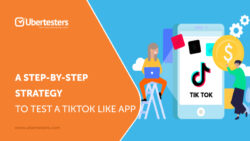The Best Practices Of Remote Testing

Usability testing an inevitable part of any QA process. It is all about making users interact with your product or website to evaluate its user experience and gain valuable user feedback. Millions of companies use this type of testing to ensure their product or service has a superior quality, making it more attractive for customers.
Remote usability testing is currently gaining popularity among both big and small businesses. Remote testing has lots of common features with traditional usability testing. The main difference between these two is that a remote QA process is performed in the natural environment of its participants. In most cases the parties are using screen sharing or other advanced remote testing tools. In other words, the facilitator and the participant of the QA process are operating in different physical locations. It is worth mentioning that this solution is becoming even more popular in the era of the COVID-19 crisis.
Usability testing tips: When you should start using remote testing?
To begin with, it is necessary to find out in which cases you might start using remote usability testing. What are the main preconditions to switch to remote testing? Most experts believe that the basic conditions to use remote testing include:
- The participants of testing are operating in different physical locations
- Your target audience is diverse, and the users are located in different parts of the world
- The project has a limited budget for performing in-lab testing
- Your customers are using lots of different types of mobile devices with various screen sizes, operating systems, and other parameters. Covering such a whopping number of devices via in-lab testing is hardly possible. This way, remote testing becomes a perfect fit for your needs.
The fact is that remote test techniques have lots of benefits. Thus, it allows using various groups of participants, provides access to many devices, eliminates the need of using lab tests, and, looking at the bottom line, is much more cost-effective.
Remote usability testing: the main types
The basic classification of remote usability testing includes two types of testing. These are remote moderated usability testing and unmoderated usability testing. Below we will discover the core features of both types of remote QA processes.
Moderated remote testing: what should you know?
The essence of moderated remote usability testing is that both the facilitator and the participant take part in the process of testing. This type of remote software test is considered to be the most fitting alternative for complex tasks that require performing lots of test cases with different parameters. To perform this type of testing, it is important to choose all the necessary test cases and create a schedule.
The testing participants should also use external communication tools, such as Zoom, Skype, GotoMeeting or other popular alternatives. The fact is that the remote testers and the moderator might be located in different parts of the world. Therefore, it is essential to use communication apps to monitor, manage, and review the recordings made during the tests.
It might be also a good idea to perform a test session and resolve all the technical issues that might occur before starting your main session. During it, you will be able to ensure the tests are completed successfully, ask questions, and perform testing according to your schedule.
The basic facts about unmoderated remote testing
Unmoderated user testing is a kind of independent testing, where the moderator is not taking part in the remote QA process. This type of service is great for simple and straightforward tasks, where you need to get the answers to specific questions about your solution. In case you are planning to perform this testing, you will need to keep in mind some important aspects:
- Select the task you need to complete
- Determine the participants of your testing session
- Be clear with the testers and provide detailed instructions for what they are required to do
- Choose either screen sharing or recording option beforehand
- Select the best methods or tools for analyzing the results of the session
The “Best of both worlds”
Still, there is a handy alternative that combines the benefits of both moderated and unmoderated testing. Using crowd testing allows receiving an advantage of using a crowd of global testers who perform unmoderated remote usability testing. However, you also get an assigned project manager from the crowd testing company. The project manager is taking the responsibility of a moderator but without being an integral part of the testing session. To put it short, you are using an unmoderated testing service but have a project manager who can answer all the testers questions during the cycle and point them in the right direction. It is also worth mentioning that crowd testing is available for much lower cost than traditional moderated testing.
How to choose usability testing best practices
All types of remote testing mentioned above require using particular testing practices. Here is a list of things you need to pay attention to before launching your session.
Set up your goals
Setting up the main purposes of your testing, as well as your target audience is an inevitable part of arranging your remote testing process. It is also necessary to select the areas and functions you would like tested in your product. Most experts create task-based scripts or blocks for more effective remote testing.
Find the users
The best hint at this stage is to recruit people that perfectly fit your target group. Crowd testing solutions might become an excellent option for these purposes. Performing tests remotely gives you tons of benefits – you can hire professionals from any country globally! However, the time zone should be taken into account when scheduling your sessions. The crowd testing company will provide “managed services” and will assign a project manager to your project. This will reduce your management overhead and the need to worry about recruiting members of time zone worries.
Create tests
Composing the test scripts is one of the most significant steps of preparing for a remote testing session. As a rule, experts create testing scenarios and collect certain questions about the experience of QA professionals in using the product. It is worth mentioning that the scenarios should be closely connected to the tasks. Make sure an expert writes the test cases to avoid confusion. It should be ‘single steps’ test cases that are easy to understand and execute.
The length of each test shouldn’t exceed 45 minutes. It is also better to focus on certain tasks and scenarios, as well as avoid testing the product altogether. The truth is that this might cause missing some important things during testing.
Run tests
Before launching your tests, it will be great to send notifications to all the parties in advance. This simple trick will help you involve all the experts in the testing process without any delays. When performing the test, it is better to create a real-life atmosphere and avoid being too fast. This can easily make the entire session smoother and more effective.
Collect the results
After all, make sure to gather the impressions of testers of using your product. Point out its strong and weak points, as well as recommendations. This will help you make your product better and pay more attention to details. You can also create an advanced usability report to put all the program’s bugs and weaknesses in the same place. Subsequently, you will be able to send this report to all your team members, including the developers and project managers.
Use remote test tools
The testers should also use various video tools and live communication apps (for example, Zoom, GotoMeeting or Skype) during the moderated testing. For unmoderated testing, it is necessary to choose modern tools to record the sessions via web or mobile, and take screenshots. Both types of testing also require using bug-tracking-solutions such as YouTrack, Jira, or Redmine to report on bugs, errors, issues, or offer recommendations/improvements.
Remote testing is gaining more popularity during the recent time. It is a fast, effective, and easy-to-use service that can save you tons of money and effort. It is by far less expensive than in-person testing and can be performed in various geographies using a variety of devices, operating systems, carriers and types of data. Crowd testing is the preferred alternative for conducting remote testing and it provides the benefits of both methods in one place…the moderated and unmoderated combined in one, single, flexible and easy to use service.
Want to know more about testing your product remotely, and launching a much better and well tested product – contact us at sales@ubertesters.com

